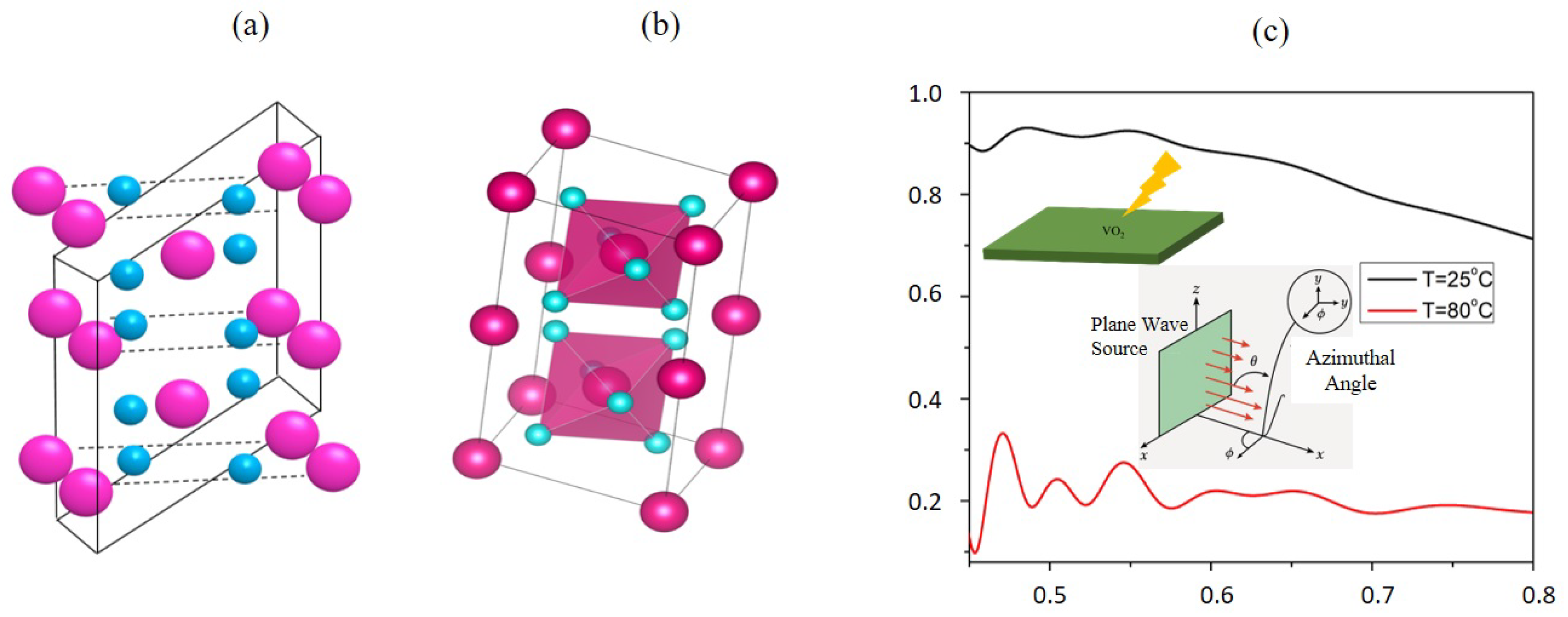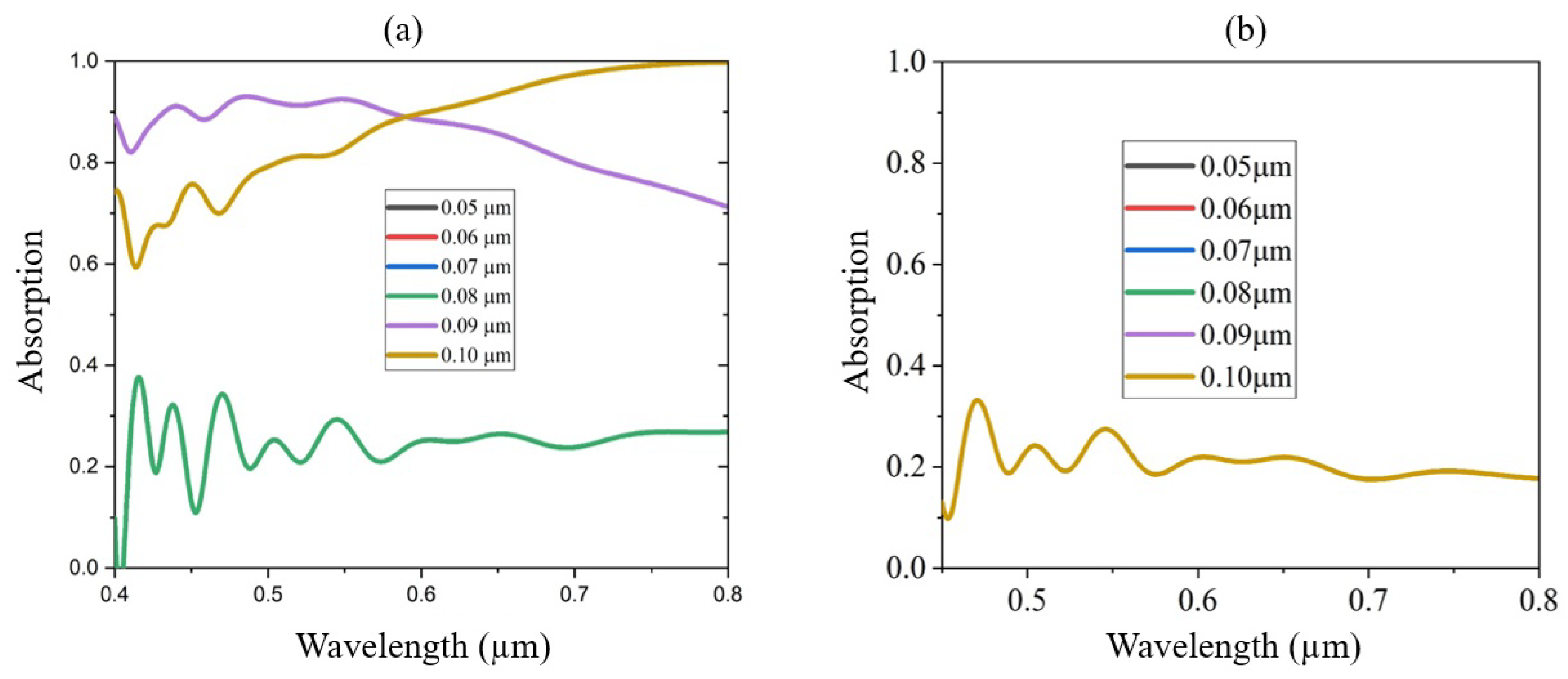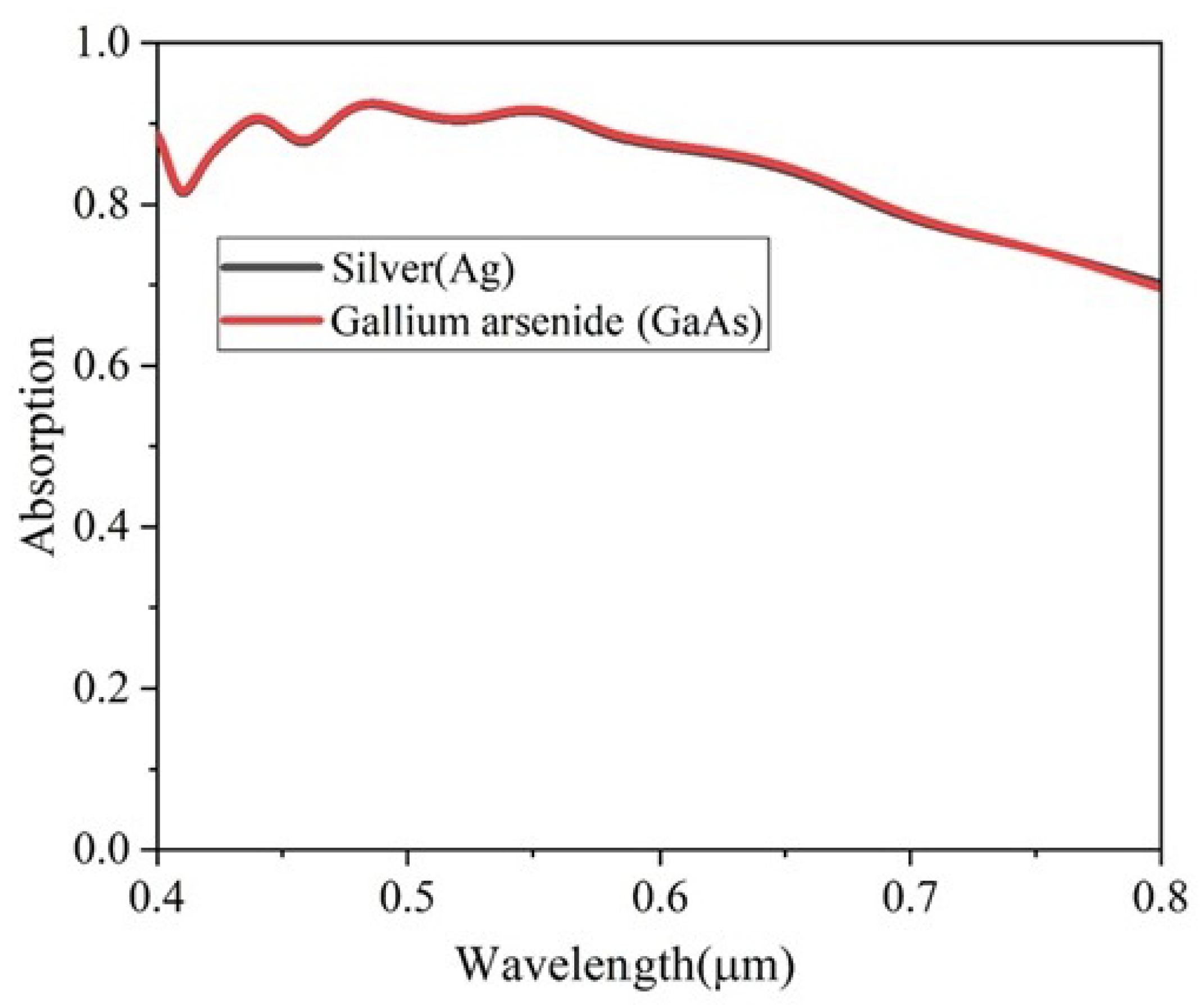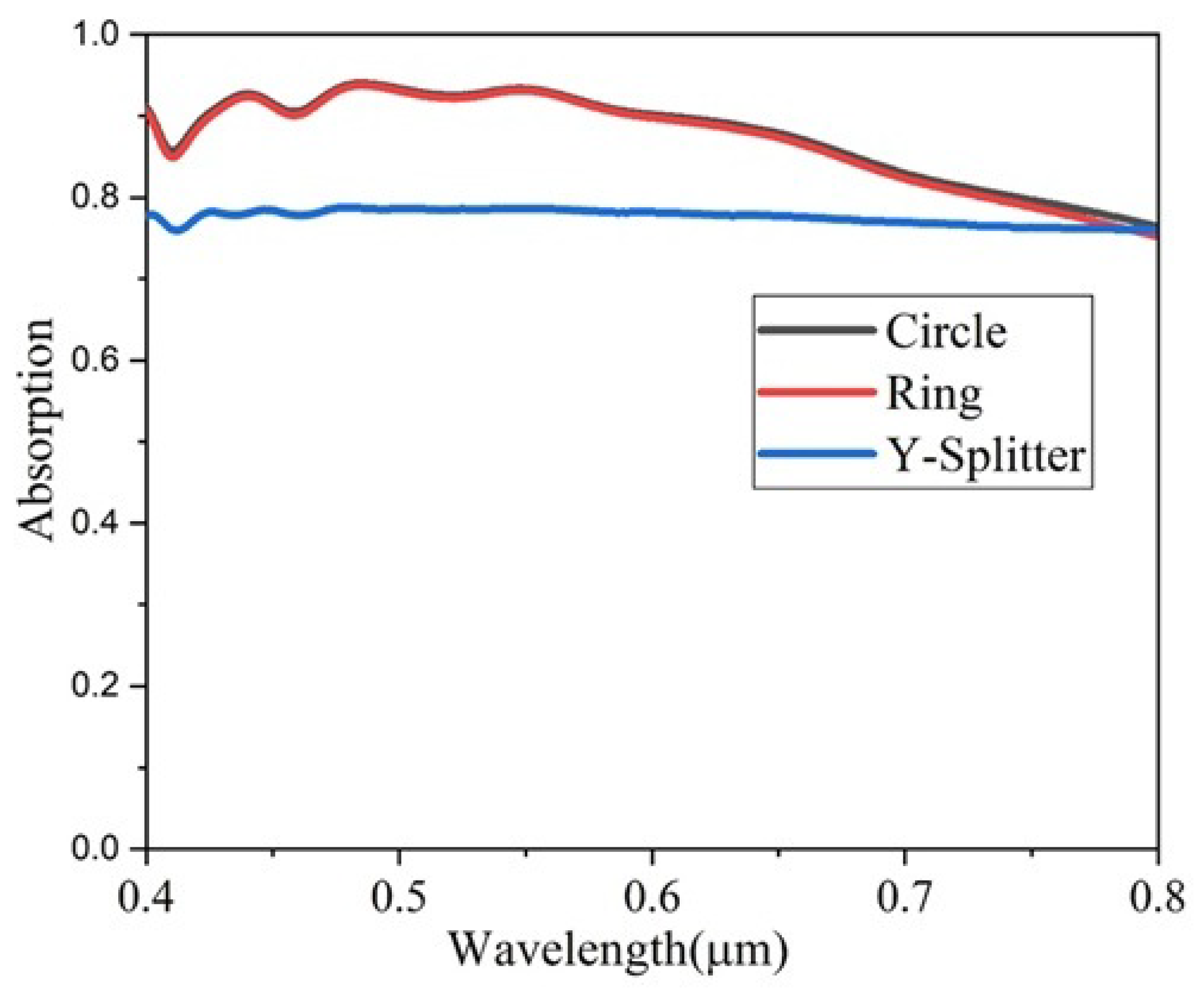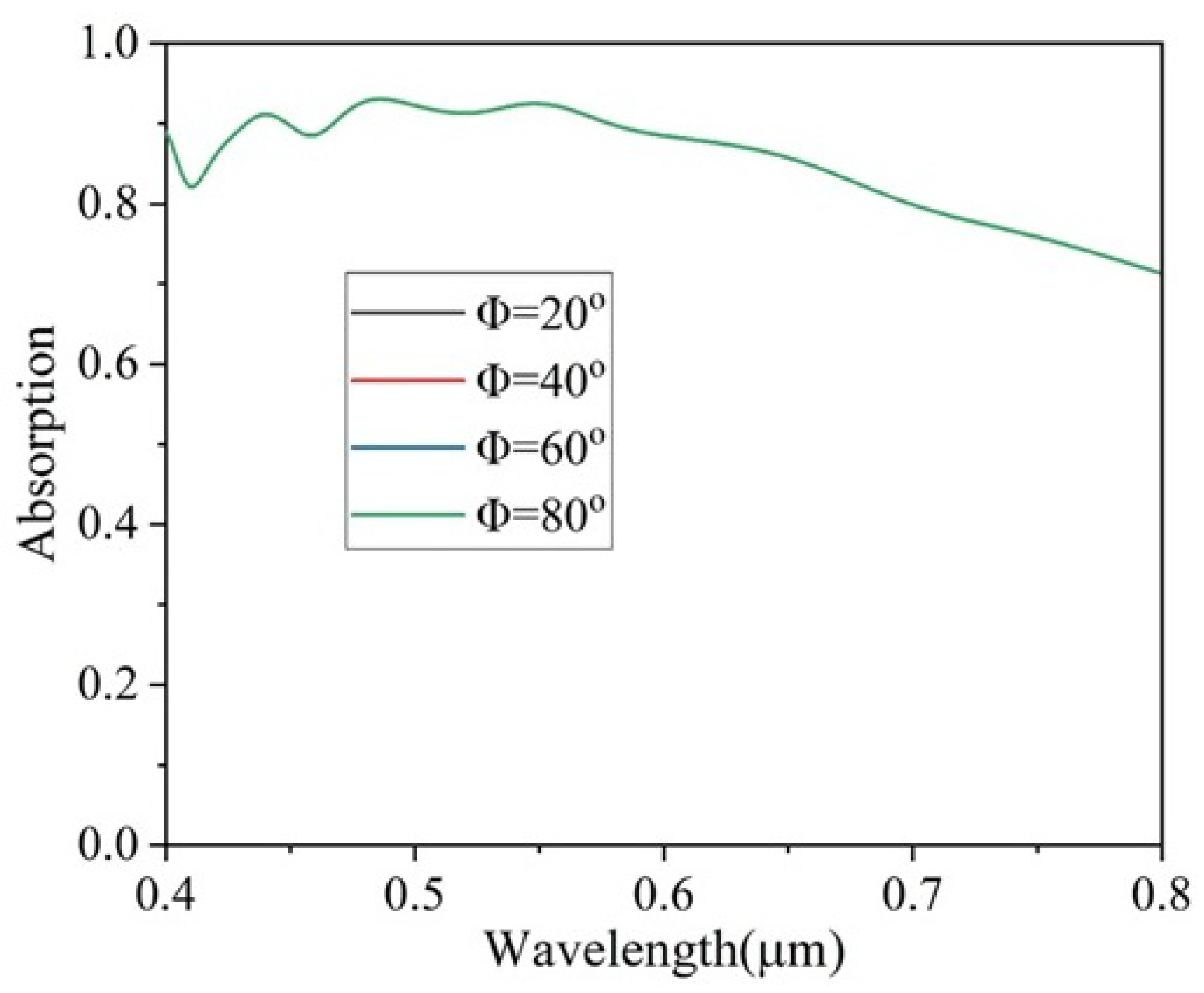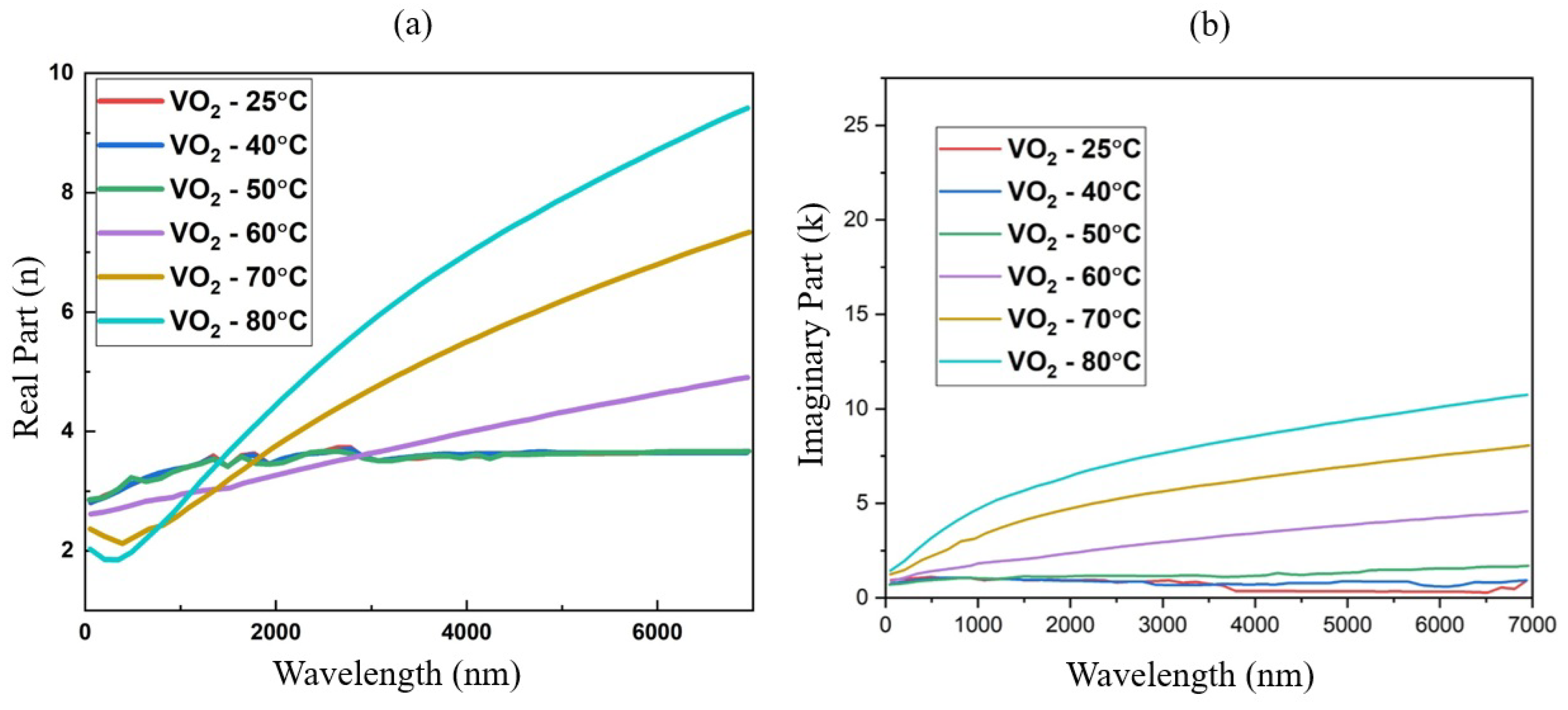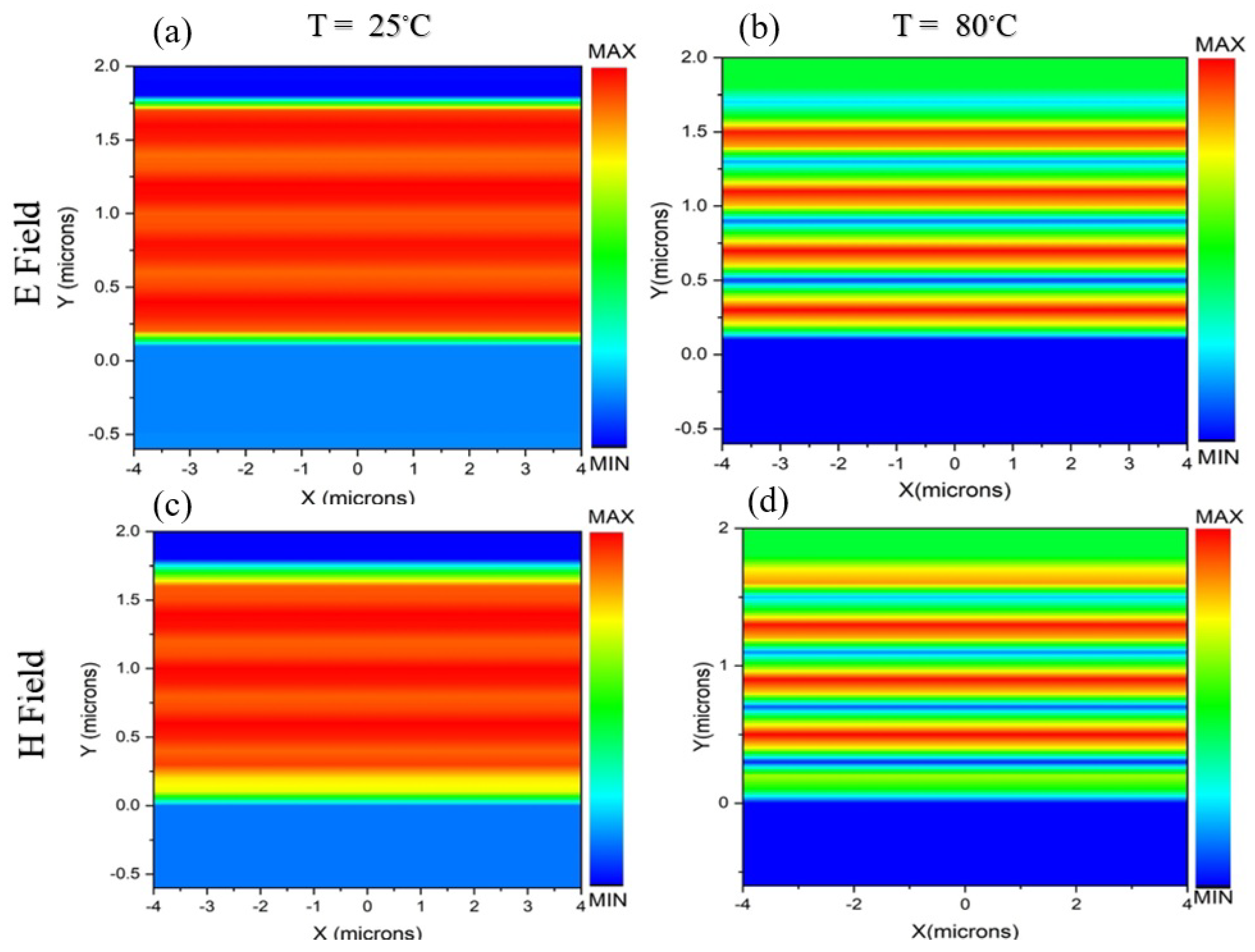1. Introduction
Vanadium dioxide (VO
2) is a widely studied phase-change material that undergoes a thermally driven insulator-to-metal transition (IMT) at approximately 68 °C, making it highly suitable for tunable thermal sensors, memory devices, and other energy storage applications [
1,
2,
3,
4,
5]. These properties are driven by structural changes in the VO
2 crystal lattice, specifically the shift from a monoclinic insulating phase to a rutile metallic phase [
6,
7]. This phase transition leads to dramatic shifts in the optical properties of VO
2, which have enabled the development of tunable metamaterial devices, particularly in the near-infrared regime [
8]. These phase-driven changes also significantly impact conductivity and other physical properties, allowing real-time control over light absorption, reflection, and transmission across various wavelength ranges [
9,
10]. The capability of VO
2 to dynamically alter its optical properties has driven significant exploration into its use in adaptive coatings, tunable photonic systems, thermochromic windows, and advanced optoelectronic technologies [
11,
12,
13,
14].
Despite these advantages, traditional VO
2-based optical absorbers face several challenges. Numerous designs depend on bulk films or multilayered architectures, which introduce challenges such as intricate fabrication processes, higher material expenses, and limited scalability [
15,
16]. Additionally, achieving precise control over the phase transition demands sophisticated thermal management, which hinders practical implementation. Intrinsic optical losses in both the insulating and metallic phases further diminish absorption efficiency, impacting overall device performance [
17,
18]. Furthermore, the narrow temperature range of the insulator-to-metal transition (IMT) at 68 °C restricts operational flexibility, requiring meticulous tuning for real-world applications. Recent progress in thin-film and nanostructured VO
2 materials has unlocked new opportunities for monolayer VO
2 absorbers, enabling substrate-independent functionality and improved tunability [
19,
20]. In this work, we present a detailed numerical study of the optical performance of a monolayer VO
2 absorber, employing full-wave simulations to analyze its tunability in the visible spectrum. By leveraging the intrinsic phase-transition characteristics of the VO
2 crystal lattice, monolayer VO
2 can function as an efficient, energy-responsive optical absorber in the visible spectrum (400–700 nm) [
9,
21]. Additionally, the substrate-free design of the proposed absorber improves its versatility, enabling seamless integration into various optical systems without compromising performance [
11]. The numerical results provide substrate independent insight into absorption behavior under varying thermal conditions, supporting the design of efficient, reconfigurable optical devices. These advancements contribute to ongoing efforts in developing tunable, energy-efficient optical materials, paving the way for future experimental validation and practical applications in fields such as thermal camouflage, optical modulation, and high-speed photonic switching [
13,
22,
23]. The primary contributions of this work include.
Development of a Monolayer VO2-Based Optical Absorber for the Visible Spectrum: This study introduces a simplified, single-layer VO2 optical absorber that eliminates the need for intricate structural designs while delivering high-contrast optical switching performance. The absorber achieves an impressive 95% absorption in the insulating phase at 25 °C and drops to less than 20% absorption in the metallic phase at 80 °C, showcasing remarkable tunability across the visible spectrum. These findings are supported by full-wave numerical simulations that model the thermally induced optical behavior of VO2.
The substrate-independent design enhances its flexibility, making it adaptable to diverse environments and simplifying substrate independent integration into various systems. Built on bulk film technology, the design is scalable, allowing it to be tailored for a wide range of application-specific solutions. The numerical framework also enables predictive modeling across a variety of structural and environmental conditions.
The design leverages the intrinsic phase-transition properties of VO2, enabling dynamic optical modulation with high efficiency. As a simplified single-layer structure, it offers ease of fabrication and reduced production costs, making it highly suitable for applications in catalysis, energy storage, thermoelectric devices, and high-speed optical switching. Simulation results confirm consistent modulation performance across the target wavelength range, validating the absorber’s application potential.
In summary, our work presents several distinguishing features that set it apart from existing studies on phase-change optical absorbers. While many prior efforts have focused on conventional multilayer structures or GST-based platforms, our approach centers on a simplified, tunable, and scalable design. The novelty of our work lies in both the material configuration and performance-driven design methodology, as outlined below:
We focus on substrate-independent, monolayer VO2 designs for minimal-cost, scalable fabrication.
Unlike many prior studies relying on GST or bulk VO2 films, our design emphasizes thin-film, patterned monolayers, enhancing field confinement and device responsiveness.
We compare multiple geometric patterns (rectangular, circular, Y-splitter, and cross-shaped), demonstrating design versatility and performance tunability—an aspect not systematically analyzed in previous works.
The absorption contrast and extinction ratio achieved in our work (9.7 and 37.45 dB, respectively) surpass many reported values for similar devices [
24,
25].
Simulations conducted across various incident and polarization angles, revealing that the absorption remains nearly unchanged. This angular and polarization insensitivity highlights the robustness and versatility of the proposed optical switch for practical applications.
The next section gives a good overview of the design of phase-drive optical absorption in monolayer VO
2.
Section 3 presents the simulation and performance analysis of the design and
Section 4 concludes the paper.
3. Phase-Driven Optical Absorption: Simulation and Performance Analysis
To evaluate the performance of the proposed single-layer VO
2 absorber, we analyze its structural design and optical response. The absorber’s functionality relies on the insulator-to-metal transition (IMT) of VO
2, which enables dynamic modulation of light absorption. By leveraging VO
2’s high refractive index in the insulating phase, the design maximizes light trapping and absorption, making it highly efficient in the visible spectrum. The following section presents a detailed examination of the absorber’s structure and optical properties, illustrating its tunable absorption behavior across different temperatures.
Figure 1a,b provide a three-dimensional schematic of the single-layer VO
2 absorber. The VO
2 layer, with a thickness of 0.1
m, is the active component responsible for absorption. The design does not include a substrate to illustrate its optical independence. The schematic highlights the absorber’s simplicity compared to multilayer structures while emphasizing VO
2’s unique properties. The physics behind this design lies in VO
2’s high refractive index and phase transition. In its insulating state, VO
2 traps light via resonances within the thin layer, maximizing absorption. This visualization aids in understanding the physical configuration of the absorber and its feasibility for fabrication. This
Figure 1c highlights the tunable optical absorption of the VO
2 absorber across the visible wavelength range (400–800 nm) at two key temperatures: 25 °C (insulating phase) and 80 °C (metallic phase). At 25 °C, the material’s insulating state exhibits a high refractive index and significant optical losses due to strong light-matter interactions, resulting in nearly 95% absorption in the visible range. At 80 °C, the phase transition to the metallic state significantly reduces optical losses, and the material becomes highly reflective, reducing average absorption around 20%. The physics underpinning this behavior is the thermally driven IMT, where the electronic structure of VO
2 changes, altering its optical constants. This figure highlights the absorber’s ability to dynamically modulate light absorption, demonstrating its potential for applications like optical switches.
Figure 2a presents the effect of VO
2 layer thickness on absorption efficiency across the visible spectrum at 25 °C (insulating phase). The simulation results for thicknesses ranging from 0.05
m to 0.10
m demonstrate a gradual increase in absorption with layer thickness, with a notable rise observed at 0.09
m and 0.10
m, where absorption exceeds 80%. This highlights the strong influence of thickness on optical performance. For thinner layers (0.05
m to 0.08
m), overlapping absorption peaks are observed, indicating similar spectral behavior within this range. The VO
2 exhibits high optical conductivity, leading to no variation in absorption with increasing thickness. This behavior can be attributed to the material’s strong free-electron response, which results in a shallow skin depth, typically in the range of a few nanometers. Once the VO
2 layer exceeds this certain thicknesses, additional thickness does not contribute significantly to absorption, as most incident light is transmitted through structure within the initial few nanometers.
Figure 2b illustrates the absorption spectra of the VO
2 absorber in its metallic state at 80 °C. The results reveal a relatively constant absorption level across all tested thicknesses, indicating that, in the metallic phase, variations in layer thickness have minimal impact on the absorber’s performance in this design. Moreover, the high negative real permittivity in the metallic phase enhances reflectivity, further suppressing absorption variations. Unlike the insulating phase, where interference effects influence absorption, the metallic phase exhibits strong reflection, leading to absorption saturation beyond a certain thickness threshold. This phenomenon indicates that for tunable absorption control, alternative approaches such as structural engineering, doping, or metasurface integration may be required to achieve a more pronounced thickness-dependent response in the metallic state.
The proposed structure was also simulated using VO
2 on a silver (Ag) substrate, and VO
2 on a gallium arsenide (GaAs) substrate as shown in
Figure 3. The results show minimal variation in the absorption response across all cases, confirming that the device operates independently of the underlying substrate. This confirms the substrate-independent nature of the proposed design, enabling seamless integration with diverse platforms while maintaining optical performance. However, there are indeed physical scenarios where the substrate or spacer material can significantly influence absorption efficiency. Factors such as substrate thickness, refractive index contrast, and resonance conditions in multilayer structures can lead to substantial variations in optical response.
To study the Effect of geometric variation on absorption performance. The proposed VO
2-based absorber was simulated using three different geometries: (i) Original rectangular structure, (ii) Circular ring, and (iii) Y-splitter. The circular ring geometry exhibits nearly identical absorption behavior compared to the original structure, demonstrating geometric robustness. The Y-splitter configuration results in a slightly reduced absorption (≈78%) due to altered field confinement and interaction area. These results shown in
Figure 4 confirm that the absorber maintains effective performance across multiple structural designs, enhancing its versatility and design flexibility.
When varying the incident angle from 20° to 80°, the absorption behavior of the monolayer VO
2-based optical absorber exhibits distinct characteristics. Initially, at lower angles, the absorption remains 85% across the 0.4
m to 8
m wavelength range as shown in
Figure 5a. As the incident angle increases to 40° and 60°, there is a slight decrease of about 5%, yet the absorption does not drop below 80%. However, at 80°, the absorption remains consistently 85% from 0.4
m to 0.74
m, but a sharp dip near zero absorption appears at 0.75
m to 0.8
m. This phenomenon is attributed to the angular dependence of the optical path length and interference effects. At smaller angles, the interaction between the incident light and the VO
2 monolayer remains strong due to efficient coupling. As the angle increases, slight deviations in the absorption occur due to changes in the effective optical path and reflectance. However, at 80°, the significant reduction in absorption near 0.75–0.8
m suggests the presence of an angle-dependent Brewster-like effect or destructive interference, where the incident light undergoes phase cancellation due to reflection-dominated losses at specific wavelengths. This behavior highlights the critical role of angular tuning in optimizing the performance of phase-driven optical absorbers.
The absorption remains nearly angle-independent up to an incident angle of 70°, demonstrating the robustness of the designed structure against angular variations. However, at 80°, the significant reduction in absorption near 0.75–0.8 m suggests the presence of an angle-dependent Brewster-like effect or destructive interference, where the incident light undergoes phase cancellation due to reflection-dominated losses at specific wavelengths. This behavior highlights the critical role of angular tuning in optimizing the performance of phase-driven optical absorbers.
The absorption characteristics of the VO
2 monolayer remain unchanged with variations in polarization angle, indicating the system’s polarization insensitivity as shown in
Figure 5b. This behavior arises due to the intrinsic symmetry and homogeneous nature of the monolayer structure, which ensures that both TE (Transverse Electric) and TM (Transverse Magnetic) modes interact similarly with the material. In conventional optical absorbers, polarization sensitivity is often observed in anisotropic or structured metamaterials, where the electromagnetic response varies with the electric field orientation. However, in this case, the monolayer VO
2 absorber exhibits an isotropic response, meaning that regardless of the polarization state, the effective absorption remains stable across the wavelength range. This robustness to polarization variations makes the design highly practical for real-world applications, ensuring consistent performance under un-polarized or randomly polarized light sources.
The absorption characteristics of the VO
2 monolayer also remain unchanged with variations in the azimuthal angle (
), confirming its angular isotropy as shown in
Figure 6. This behavior is expected for a uniform and continuous monolayer structure, where the optical response is independent of in-plane rotational changes. In structured or anisotropic metamaterials, absorption can vary with
due to asymmetry in the material pattern or periodicity. However, in this case, since the VO
2 monolayer lacks any structural anisotropy in the plane, the incident light experiences the same interaction regardless of
. This isotropic absorption ensures stable performance for various light incidence directions, making the absorber highly effective for practical applications where random or varying light orientations are encountered. Now the absorption spectra with respect to temperature has been discussed. As the temperature increases, the absorption of the VO
2 monolayer gradually decreases, exhibiting a significant drop as the phase transition progresses as shown in
Figure 7. In the lower-temperature regime, where VO
2 remains in its insulating state, the material supports strong optical absorption due to its high dielectric permittivity and minimal free carrier contribution. However, as the temperature approaches the phase transition threshold, VO
2 begins to exhibit a mixed-phase behavior, where both insulating and metallic domains coexist, leading to a moderate reduction in absorption. At higher temperatures, when VO
2 fully transitions into its metallic state, the material develops a plasmonic response, significantly increasing reflection and transmission while suppressing absorption. This transition results in a drastic drop in absorption, particularly near the critical temperature, where the material effectively behaves as a low-loss metal, preventing efficient energy dissipation. This phase-driven absorption control is a key feature of VO
2-based tunable optical devices, enabling temperature-dependent modulation of light absorption for reconfigurable photonic applications. The temperature dependence of VO
2 dielectric permittivity is expressed as [
30]:
Here,
and
denote the dielectric permittivities corresponding to the insulating and metallic phases of VO
2, respectively. Note that the real part of the permittivity of VO
2 is indeed positive in both phases in the visible range, while in the mid-infrared range, the real part of the permittivity becomes negative in the metallic phase, reflecting its plasmonic behavior. The
in (
2) represents a temperature-dependent weighting function that governs the gradual transition between these two optical states [
22]. The function
is defined as follows:
In this expression, T represents the instantaneous temperature, is the critical temperature at which the phase transition occurs, and B is a parameter that determines the sharpness or breadth of the transition region. Note that the function has a Fermi–Dirac-like distribution that governs the energy states in thermodynamic distributions.
In comparing with other published work on absorption, while Currie et al. [
22] demonstrated tunable optical properties of ultrathin VO
2 films deposited via atomic layer deposition (ALD) on sapphire, their design mainly focused on characterizing refractive index transitions and showed moderate absorptance variations, primarily in the infrared range using a passive substrate-backed configuration. In contrast, the proposed monolayer VO
2-based absorber operates without a substrate and leverages the phase transition of VO
2 to achieve dynamic and broadband absorption switching in the visible spectrum (400–700 nm). Specifically, the structure achieves a high absorption state of 95% at room temperature and drops below 20% at elevated temperatures (80 °C). This enhanced absorption control in a simpler, more compact geometry demonstrates superior efficiency, design flexibility, and integration potential for nanoscale photonic systems. Furthermore, the absence of a substrate in the proposed design avoids parasitic reflections and substrate-mode interactions, offering cleaner and more controllable optical responses features that are limited in substrate-supported designs [
22].
Figure 8a,b plot the refractive indices of VO
2 at different temperatures computed at normal incidence
. One can see that when the temperature is well below the phase transition point
, VO
2 behaves consistently as a low-loss dielectric, while as the temperature reaches
and beyond, VO
2 transforms gradually into a highly lossy metal. The refractive index data of VO
2 as a function of temperature, shown in
Figure 8, provides critical insight into the phase-dependent optical response of the material. The refractive index real part increases significantly with temperature, particularly at longer wavelengths, indicating a shift from a dielectric to a metallic-like behavior. Simultaneously, the imaginary part (k) rises, especially beyond 2000 nm, confirming enhanced free carrier absorption in the metallic phase. At lower temperatures, VO
2 remains in its insulating state, characterized by moderate n and low k, enabling strong absorption. However, as the temperature increases, the transition towards the metallic phase leads to higher reflection and reduced absorption, which is consistent with the observed decrease in absorption in our designed optical absorber. The substantial increase in k at 70 °C and 80 °C demonstrates the dominance of free carrier effects, leading to suppressed absorption due to reflection losses. This temperature-dependent modulation of the refractive index further validates the phase-driven tunability of VO
2-based absorbers, making them suitable for adaptive photonic applications.
Figure 9 illustrates the electric field (E-field) and magnetic field (H-field) distributions at two different temperatures, 25 °C (left) and 80 °C (right). At 25 °C, when VO
2 is in its insulating state, the E and H-fields exhibit a uniformly strong distribution, indicating efficient coupling and absorption of incident light. The high field intensity, as shown by the red regions, confirms that electromagnetic energy is effectively confined within the structure, resulting in strong absorption. However, at 80 °C, when VO
2 transitions into its metallic phase, the field distributions change significantly as displayed in
Figure 9b,d. The presence of layered interference patterns in both the E-field and H-field indicates increased reflection and reduced absorption due to the metallic nature of VO
2. This transformation occurs because, in the metallic phase, VO
2 exhibits a higher free carrier concentration, leading to enhanced optical reflection and a decrease in field penetration. The formation of standing wave patterns further confirms that incident light is primarily reflected rather than absorbed. This analysis directly correlates with the absorption spectra, demonstrating that as temperature increases, the material shifts from a high-absorption state to a low-absorption state. The observed field behavior reinforces the temperature-driven tunability of VO
2, making it a promising material for adaptive photonic applications, including tunable absorbers and thermal control devices.
Figure 9 visualizes the spatial distribution of the E and H fields within the VO
2 layer at both temperature states. At 25 °C, the insulating phase supports strong field localization within the VO
2 layer, indicative of resonant absorption due to constructive interference and light trapping as shown in
Figure 9a,c. This behavior stems from VO
2’s high refractive index, which enhances the interaction between the incident light and the material. At 80 °C, the metallic phase suppresses field localization due to increased reflectivity and lower optical losses, consistent with reduced absorption. The E- and H-field maps provide a physical understanding of the absorber’s performance by showing how the phase transition affects light-matter interactions.
